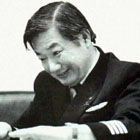UFO sightings
JAL 1628 UFO incident
Japan Air Lines flight 1628 UFO incident took place on 17th November 1986 over Alaska. Cargo aircraft Boeing 747 was en route from Paris to Tokyo with a cargo of Beaujolais wine. While they were making a part of the route from Reykjavik, Iceland to Anchorage, Alaska about 5:11 PM Captain Kenju Terauchi (very experienced ex-fighter pilot) and two other crewmembers (co-pilot Takanori Tamefuji and flight engineer Yoshio Tsukuba) noticed two or three unidentified objects to the left of their course and below their altitude. These objects were not well visible since they were flying in the shadowed part of the sky. Suddenly the objects rose from below and closed in a way they would escort JAL 1628. Each had two rectangular arrays of what appeared to be glowing nozzles or thrusters, though their bodies remained obscured by darkness. When closest, the aircraft’s cabin was lit up and the captain could feel their heat in his face. These two craft departed before a third, much larger disk-shaped object started trailing JAL 1628, causing the pilots to request a change of course. 
Soon they received from Anchorage ATC directions to head for Talkeetna, Alaska. When they made the turn Captain Terauchi noticed again the two crafts to his far left, and about 2000 feet below, which he assumed to be military aircraft. These were pacing his flight path and speed. At 5:18 or 5:19 PM the two objects abruptly veered to a position about 500 feet in front of Boeing, assuming a stacked configuration. In doing so they activated "a kind of reverse thrust, and lights [of the objects] became dazzlingly bright". To match the speed of the aircraft from their sideways approach, the objects displayed what Terauchi described as a disregard for inertia: "The thing was flying as if there was no such thing as gravity. It sped up, then stopped, then flew at our speed, in our direction, so that to us it [appeared to be] standing still. The next instant it changed course. ... In other words, the flying object had overcome gravity." When the "reverse thrust" was active captain Terauchi again could feel the warmth of their glows.
Around 5:19 PM they contacted air traffic control and asked if there was any traffic present in their position, but the answer was negative. After 3 to 5 minutes the objects assumed a side-to-side configuration, which they maintained for another 10 minutes. They accompanied the aircraft with an sinuous motion, and some back and forth rotation of the jet nozzles, which seemed to be under automatic control, causing them to flare with brighter or duller luminosity. The objects left abruptly at about 5:23 PM, moving to a point below the horizon to the east.
Where the first objects disappeared, Captain Terauchi now noticed a pale band of light that mirrored their altitude, speed and direction. Setting their onboard radar scope to a 25 nautical miles range, he confirmed an object in the expected 10 o’clock direction at about 7.5 miles distance, and informed ATC of its presence. Anchorage found nothing on their radar, but Elmendorf ROCC, directly in his flight path, reported a "surge primary return" after some minutes. As the city lights of Fairbanks began to illuminate the object, captain Terauchi believed to perceive the outline of a gigantic spaceship on his left side that was "twice the size of an aircraft carrier" and shaped like bulky disc or a nut. It was however outside first officer Tamefuji’s field of view. Terauchi immediately requested a change of course to avoid it. The crew of JAL 1628 tried the 45 degree turn, descent from 35000 to 31000 feet and later even 360 degrees turn, but the object kept the same position and same distance from Boeing, but Fairbanks airport was unable to detect the object on ther short-range radar.
Anchorage ATC offered military intervention, which was declined by Captain Terauchi, who recalled the the Mantell UFO incident, in which military pilot was killed while chasing unidentified flying object. With no other options Anchorage Air Traffic Control requested an oncoming United Airlines flight and military craft nearby to confirm the unidentified traffic near JAL 1628. At about 5:51 PM they did got into visual contact with Boeing, but could not confirm any sign of the object. At the same time JAL 1628 lost the sight of the object. At 6:20 PM they landed safely at Anchorage. For official Federal Aviation Administration report Captain Terauchi stated that it was UFO and about month later he was grounded by Japan Air Lines for talking to the press and was transferred to a desk job. He was briefly reinstated as pilot years later.
Official investigation was started in December 1986 and John Callahan, the FAA Division Chief of the Accidents and Investigations, considered different elements, including the early stages of stealth planes testing. He tried to synchronize the the radar data with the voice tapes, but when that material reached Vice Admiral Donald D. Engen he asked the investigators not to talk anybody until they will get the clearance. The meeting was organized with representatives of the FBI, CIA and President Reagan’s Scientific Study Team, among others. Upon completion of the presentation, all present were told that the incident was secret and that their meeting "never took place". According to Callahan, the officials considered the data to represent the first instance of recorded radar data on a UFO, and they took possession of all the presented data. John Callahan however managed to retain the original video material, the pilot’s report and the FAA’s first report in his office. The forgotten target print-outs of the computer data were also rediscovered, from which all targets can be reproduced that were in the sky at the time.
After a three-month investigation, the FAA formally released their results at a press conference held on 5th March 1987. Paul Steucke retracted earlier FAA suggestions that their controllers confirmed a UFO, and ascribed it to a "split radar image" which appeared with unfortunate timing. He clarified that "the FAA [did] not have enough material to confirm that something was there", and though they were "accepting the descriptions by the crew" they were "unable to support what they saw".
On 29 January 1987 at 6:40 PM Alaska Airlines Flight 53 observed a fast moving object on their onboard weather radar. While at 35000 feet about 60 miles west of McGrath, on a flight from Nome to Anchorage, the radar registered a strong target in their 12 o’clock position, at 25 miles range. While they could not distinguish any object or light visually, they noticed that the radar object was increasing its distance at a very high rate. With every sweep of their radar, about 1 second apart, the object added five miles to its distance, translating to a speed of 18000 mph. The pilot however relayed a speed of "a mile a second" to the control tower, or a speed of 3600 mph, but confirmed that the target exceeded both the 50 miles and 100 miles ranges of their radar scope in a matter of seconds. The object was outside the radar range of the Anchorage ARTCC and additional radar data covering the specified time and location failed to substantiate the pilots’ claim.
A US Air Force KC-135 jet flying from Anchorage to Fairbanks once again observed a very large, disk-shaped object on 30th January 1987. The pilot reported that the object was 12 miles from the aircraft and soon disappeared out of sight.
Can you solve a mystery like this one?
 add comment
add comment







